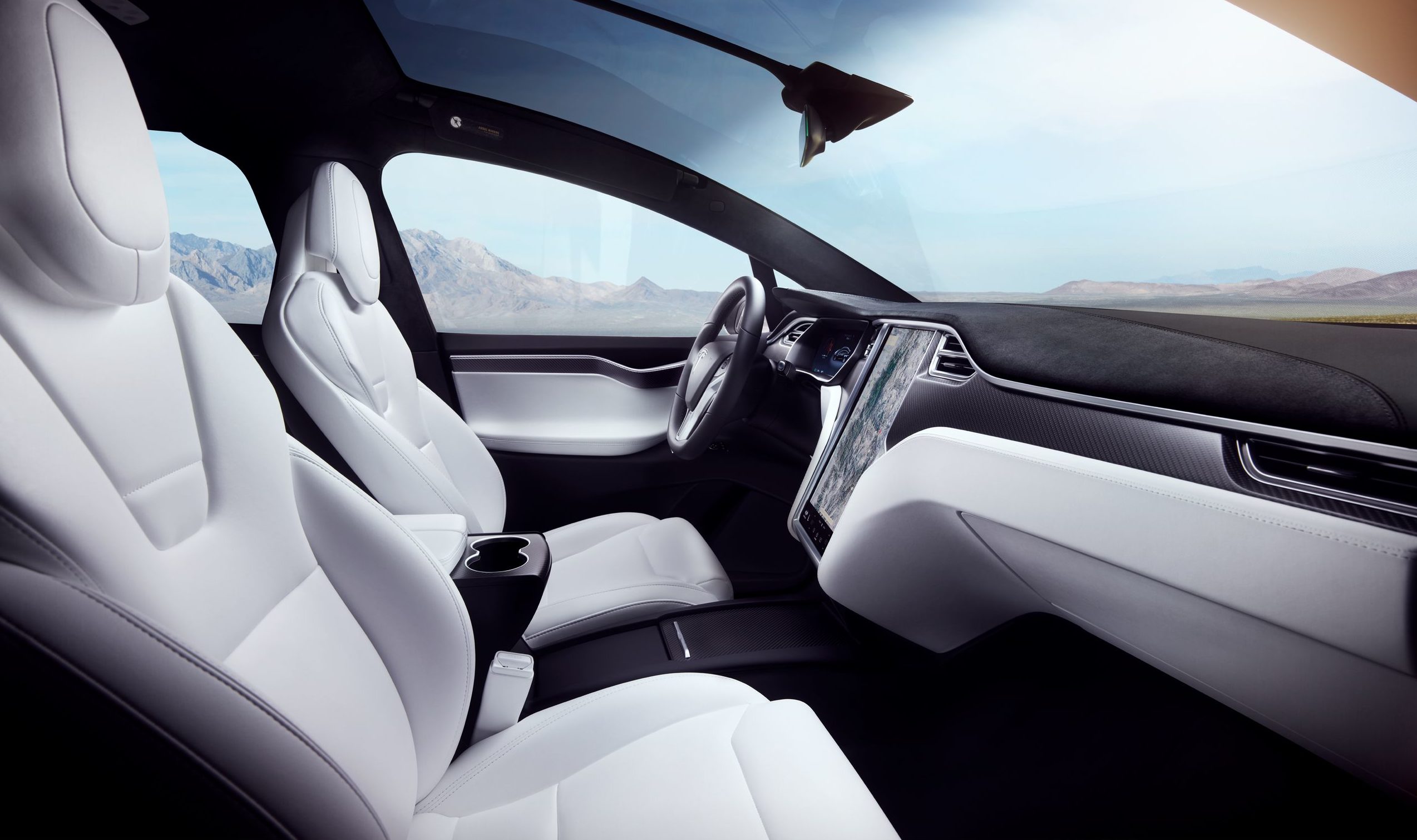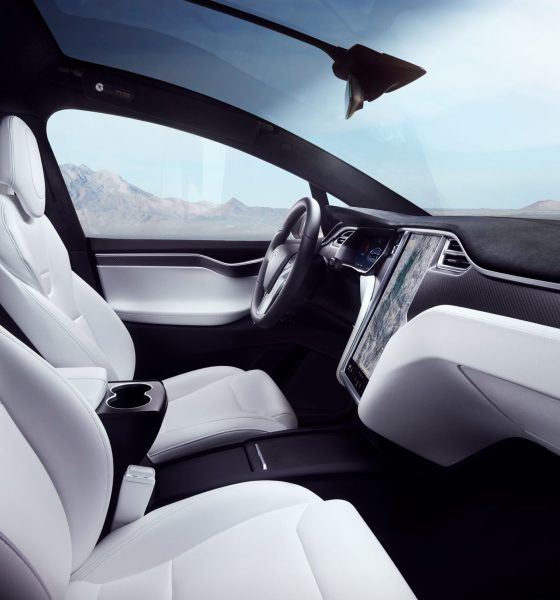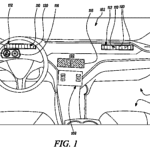

News
Tesla patent hints at possible Model S, X refresh with new HVAC system
Details coming out of a new international patent application filed by Tesla reveals an infotainment-controlled HVAC system that could be intended for an upcoming Model S and Model X refresh.
A similar HVAC control system has already been rolled out by Tesla in its compact electric sedan, the Model 3. The Model 3 uses two intersecting planes of air for vertical control. Lateral fins hidden within the electric car’s dashboard provide horizontal air control while also providing a clean, minimalistic look. Tesla’s filed patent describes features that are similar to Model 3’s air vent system that’s controlled through its 15″ center touchscreen. Patent US2017 / 058015 titled “Infotainment System with Air-Vent Control,” describes a system to manipulate the airflow inside the vehicle through the vehicle’s media control unit.
The air vent assembly includes a first vent portion placed in front of the driver and a second vent portion that is placed in front of the passenger. These vent portions may be elongated as compared to traditionally known designs of air vent assemblies in that they have longer, more linear vents instead of more circular or boxy vents.
Embodiments of the present disclosure enhance the capabilities of this air vent assembly to provide air flow in a leftward, rightward, onward, and a split configuration using a single rotary actuator. In certain embodiments, the user interface may also allow a user to define the degree to which the vents may cause air to flow in the rightward, leftward, or split direction.
Similar to Model 3’s unique HVAC system, the one described in the patent application also allows passengers to customize the airflow within the vehicle according to passenger preferences.
In certain embodiments, the user customizes the airflow, for example, the specific direction of the airflow. This can allow for a more comfortable experience for the occupants of a vehicle. For example, certain occupants may desire for air to be directed towards themselves while other occupants may desire the temperature of the vehicle cabin to be set to a certain value without having air directly impinging on themselves.
An illustration of Tesla’s recent patent on an infotainment-controlled HVAC system. [Credit: World Intellectual Property Organization]
With anticipation running high that Model S and Model X is due for a refresh, an update to its HVAC system would not only unify the dashboard design across its fleet of vehicles but could also simplify production. For one, Tesla’s unique air vent system requires less hardware and thus minimizes the need for multiple suppliers. Using a simpler design, Tesla’s thinner HVAC system can efficiently utilize space in the dashboard, and provide a much more expansive interior feel. Such a system, as proven by the Model 3, would also give drivers better road visibility.
While Tesla’s international patent application did not specifically mention a vehicle model, illustrations included in the document resembles the design of the Model S and Model X’s dashboard. Figure 1, for example, features a dashboard that is similar to the all-electric luxury sedan and SUV. Apart from a similar-looking instrument cluster and infotainment system, the illustration also features a dashboard curvature that’s aligned with that of Model S and Model X’s current design. Armrest cupholders located between the front seats at the bottom of Fig. 1 also draws resemblance to ones found in the Model S and Model X.
Adopting an HVAC system that’s akin to the Model 3 for the Model S and Model X would likely be a welcomed change for Tesla enthusiasts. During his testing and teardown of the vehicle earlier this year alone, Detroit veteran Sandy Munro, who issued a harsh critique of the electric car’s build quality, admitted in a later comment that the Model 3’s HVAC system was “brilliant,” citing its simple yet ingenious design.
Aside from major refreshes, Tesla continues to improve the components of its vehicles over time. As revealed by Elon Musk in a recent conversation with Consumer Reports’ Jake Fisher, the Tesla CEO noted that improvements have been rolled out to the Model 3 since its production began, from better interior materials that reduce road noise to a software update that improves the vehicles’ controls. Tesla’s flagship Model S and Model X are no strangers to this, and a revamped HVAC system can only improve the experience for its driver and passengers.

News
Tesla starts showing how FSD will change lives in Europe
Local officials tested the system on narrow country roads and were impressed by FSD’s smooth, human-like driving, with some calling the service a game-changer for everyday life in areas that are far from urban centers.

Tesla has launched Europe’s first public shuttle service using Full Self-Driving (Supervised) in the rural Eifelkreis Bitburg-Prüm region of Germany, demonstrating how the technology can restore independence and mobility for people who struggle with limited transport options.
Local officials tested the system on narrow country roads and were impressed by FSD’s smooth, human-like driving, with some calling the service a game-changer for everyday life in areas that are far from urban centers.
Officials see real impact on rural residents
Arzfeld Mayor Johannes Kuhl and District Administrator Andreas Kruppert personally tested the Tesla shuttle service. This allowed them to see just how well FSD navigated winding lanes and rural roads confidently. Kruppert said, “Autonomous driving sounds like science fiction to many, but we simply see here that it works totally well in rural regions too.” Kuhl, for his part, also noted that FSD “feels like a very experienced driver.”
The pilot complements the area’s “Citizen Bus” program, which provides on-demand rides for elderly residents who can no longer drive themselves. Tesla Europe shared a video of a demonstration of the service, highlighting how FSD gives people their freedom back, even in places where public transport is not as prevalent.
What the Ministry for Economic Affairs and Transport says
Rhineland-Palatinate’s Minister Daniela Schmitt supported the project, praising the collaboration that made this “first of its kind in Europe” possible. As per the ministry, the rural rollout for the service shows FSD’s potential beyond major cities, and it delivers tangible benefits like grocery runs, doctor visits, and social connections for isolated residents.
“Reliable and flexible mobility is especially vital in rural areas. With the launch of a shuttle service using self-driving vehicles (FSD supervised) by Tesla in the Eifelkreis Bitburg-Prüm, an innovative pilot project is now getting underway that complements local community bus services. It is the first project of its kind in Europe.
“The result is a real gain for rural mobility: greater accessibility, more flexibility and tangible benefits for everyday life. A strong signal for innovation, cooperation and future-oriented mobility beyond urban centers,” the ministry wrote in a LinkedIn post.
News
Tesla China quietly posts Robotaxi-related job listing
Tesla China is currently seeking a Low Voltage Electrical Engineer to work on circuit board design for the company’s autonomous vehicles.

Tesla has posted a new job listing in Shanghai explicitly tied to its Robotaxi program, fueling speculation that the company is preparing to launch its dedicated autonomous ride-hailing service in China.
As noted in the listing, Tesla China is currently seeking a Low Voltage Electrical Engineer to work on circuit board design for the company’s autonomous vehicles.
Robotaxi-specific role
The listing, which was shared on social media platform X by industry watcher @tslaming, suggested that Tesla China is looking to fill the role urgently. The job listing itself specifically mentions that the person hired for the role will be working on the Low Voltage Hardware team, which would design the circuit boards that would serve as the nervous system of the Robotaxi.
Key tasks for the role, as indicated in the job listing, include collaboration with PCB layout, firmware, mechanical, program management, and validation teams, among other responsibilities. The role is based in Shanghai.
China Robotaxi launch
China represents a massive potential market for robotaxis, with its dense urban centers and supportive policies in select cities. Tesla has limited permission to roll out FSD in the country, though despite this, its vehicles have been hailed as among the best in the market when it comes to autonomous features. So far, at least, it appears that China supports Tesla’s FSD and Robotaxi rollout.
This was hinted at in November, when Tesla brought the Cybercab to the 8th China International Import Expo (CIIE) in Shanghai, marking the first time that the autonomous two-seater was brought to the Asia-Pacific region. The vehicle, despite not having a release date in China, received a significant amount of interest among the event’s attendees.
Elon Musk
Elon Musk and Tesla AI Director share insights after empty driver seat Robotaxi rides
The executives’ unoccupied tests hint at the rapid progress of Tesla’s unsupervised Robotaxi efforts.

Tesla CEO Elon Musk and AI Director Ashok Elluswamy celebrated Christmas Eve by sharing personal experiences with Robotaxi vehicles that had no safety monitor or occupant in the driver’s seat. Musk described the system’s “perfect driving” around Austin, while Elluswamy posted video from the back seat, calling it “an amazing experience.”
The executives’ unoccupied tests hint at the rapid progress of Tesla’s unsupervised Robotaxi efforts.
Elon and Ashok’s firsthand Robotaxi insights
Prior to Musk and the Tesla AI Director’s posts, sightings of unmanned Teslas navigating public roads were widely shared on social media. One such vehicle was spotted in Austin, Texas, which Elon Musk acknowleged by stating that “Testing is underway with no occupants in the car.”
Based on his Christmas Eve post, Musk seemed to have tested an unmanned Tesla himself. “A Tesla with no safety monitor in the car and me sitting in the passenger seat took me all around Austin on Sunday with perfect driving,” Musk wrote in his post.
Elluswamy responded with a 2-minute video showing himself in the rear of an unmanned Tesla. The video featured the vehicle’s empty front seats, as well as its smooth handling through real-world traffic. He captioned his video with the words, “It’s an amazing experience!”
Towards Unsupervised operations
During an xAI Hackathon earlier this month, Elon Musk mentioned that Tesla owed be removing Safety Monitors from its Robotaxis in Austin in just three weeks. “Unsupervised is pretty much solved at this point. So there will be Tesla Robotaxis operating in Austin with no one in them. Not even anyone in the passenger seat in about three weeks,” he said. Musk echoed similar estimates at the 2025 Annual Shareholder Meeting and the Q3 2025 earnings call.
Considering the insights that were posted Musk and Elluswamy, it does appear that Tesla is working hard towards operating its Robotaxis with no safety monitors. This is quite impressive considering that the service was launched just earlier this year.











